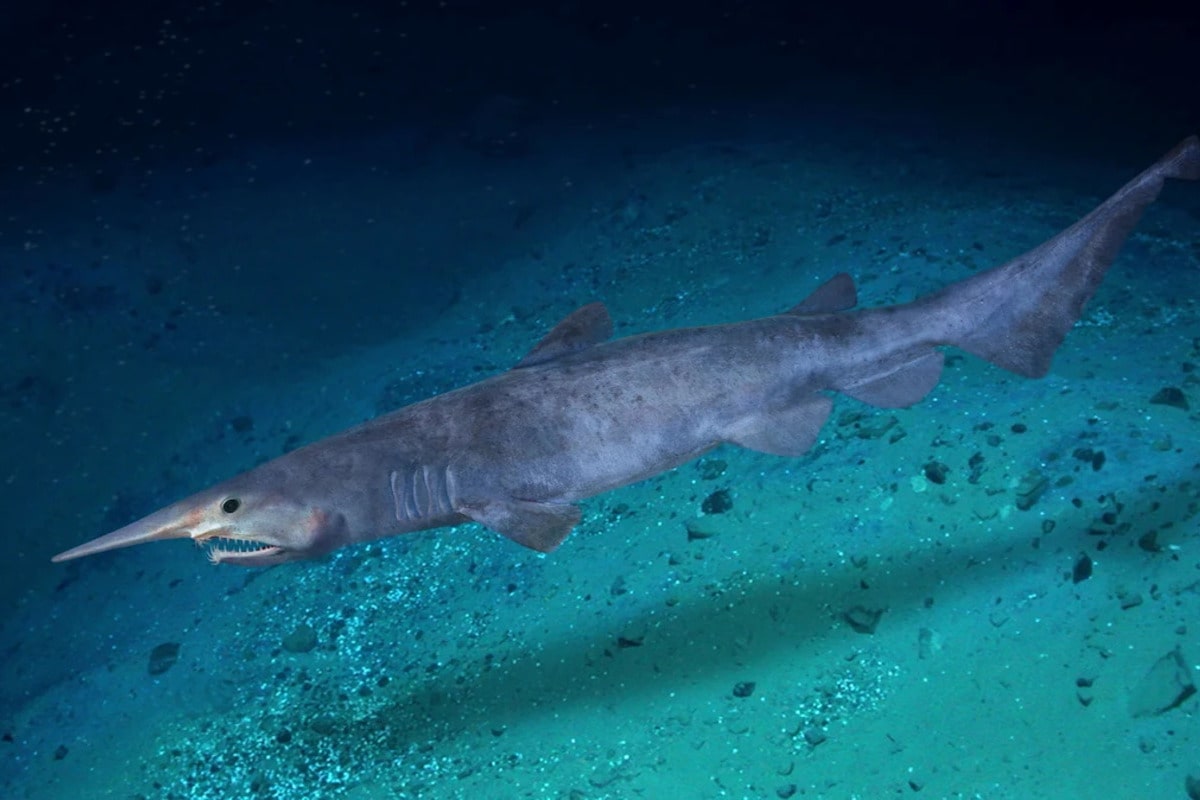Among all shark species, goblin sharks are considered some of the most mysterious and unusual creatures in the ocean. Their bizarre appearance, rare anatomical traits, and poorly understood lifestyle spark curiosity among scientists and nature enthusiasts alike. These marine predators are often referred to as living fossils, having changed very little over millions of years. Despite their frightening looks, they pose no danger to humans and are rarely encountered. Here are some interesting and astonishing facts about goblin sharks that you may not have known.
- Goblin sharks are known for their flattened, elongated snouts and jaws that can rapidly protrude forward. This adaptation allows them to capture prey in a fraction of a second. Their jaws can extend up to 10 percent of their body length. This mechanism is considered one of the fastest among marine predators.
- The goblin shark was first discovered in 1898 off the coast of Japan. Its strange appearance shocked researchers and quickly made it a symbol of deep-sea mystery. The species’ scientific name is Mitsukurina owstoni. It honors two Japanese zoologists who were the first to study the shark.
- This species is considered a living fossil because it has remained nearly unchanged since the Jurassic period. The oldest known goblin shark fossils are over 125 million years old. Their evolutionary stability indicates excellent adaptation to deep-sea environments. They have survived multiple mass extinction events.
- Goblin sharks live at great depths, usually ranging from 100 to 1200 meters below the surface. They are most commonly found in the western Pacific Ocean but also occur in the Atlantic and Indian Oceans. They avoid light and rarely rise to shallow waters. Observing them requires specialized deep-sea equipment.
- The body color of a goblin shark is pinkish or gray-pink due to blood vessels visible through its translucent skin. This gives them a ghostly and eerie appearance. At the same time, this coloration helps with camouflage in the darkness of deep waters. It allows them to stay hidden from both prey and potential predators.
- Goblin sharks are not active hunters like white or tiger sharks. They ambush their prey by striking quickly with their protruding jaws. Their diet includes deep-sea fish, squid, shrimp, and crabs. With sensitive electroreceptors, they can detect even the slightest muscle movements of nearby animals.
- Despite their terrifying look, goblin sharks pose no threat to humans. They inhabit depths where human presence is extremely rare. All known encounters have occurred during accidental capture by deep-sea trawlers. In the wild, they avoid contact and exhibit passive behavior.
- Adult goblin sharks can grow to lengths of 3.5 to 4 meters, and some specimens have exceeded 5 meters. Newborn sharks are about 80 centimeters long. Very little is known about their reproduction or development. They likely give birth to live young, as most deep-sea sharks do.
- Their jaws are lined with long, slender, fang-like teeth. This dental structure is ideal for gripping slippery prey. Goblin shark teeth regenerate throughout their lives. This ensures hunting efficiency even in older individuals.
- The distinctive elongated snout is thought to be a sensory organ. It is covered with ampullae of Lorenzini that detect electric fields. This allows goblin sharks to hunt in total darkness. Such an ability is a major advantage in the deep-sea environment.
- Goblin sharks do not survive long in captivity. Most specimens die within a few days of being caught. This is due to dramatic changes in pressure, temperature, and lighting. Most of what we know about them comes from observations in the wild or the study of deceased specimens.
- Their slow metabolism and limited movement are adaptations to environments with low oxygen and scarce food. They can go long periods without eating. Their ambush strategy allows them to conserve energy. This is a common trait among many deep-sea creatures.
- Goblin sharks are not targeted by commercial fisheries due to their rarity and low market value. Their meat is considered unpalatable, and they are difficult to catch. Occasionally, they are caught unintentionally with other deep-sea species. Scientists advocate for full protection of the species due to its scientific importance.
- Because of their rarity and strange appearance, goblin sharks have inspired many myths and stories in popular culture. They are often portrayed as deep-sea monsters. In reality, they are slow-moving, vulnerable animals that have remained largely unchanged for millions of years. They are a valuable key to understanding the evolution of cartilaginous fish.
These fascinating facts about goblin sharks show how extraordinary and understudied the deep ocean world truly is. You may not have known that this rare species retains traits dating back to the Jurassic era and still survives in the depths of our oceans. Despite their fearsome look, they are harmless and of great scientific interest. Creatures like these help us better understand marine biodiversity and the evolutionary processes that shape life on Earth.





